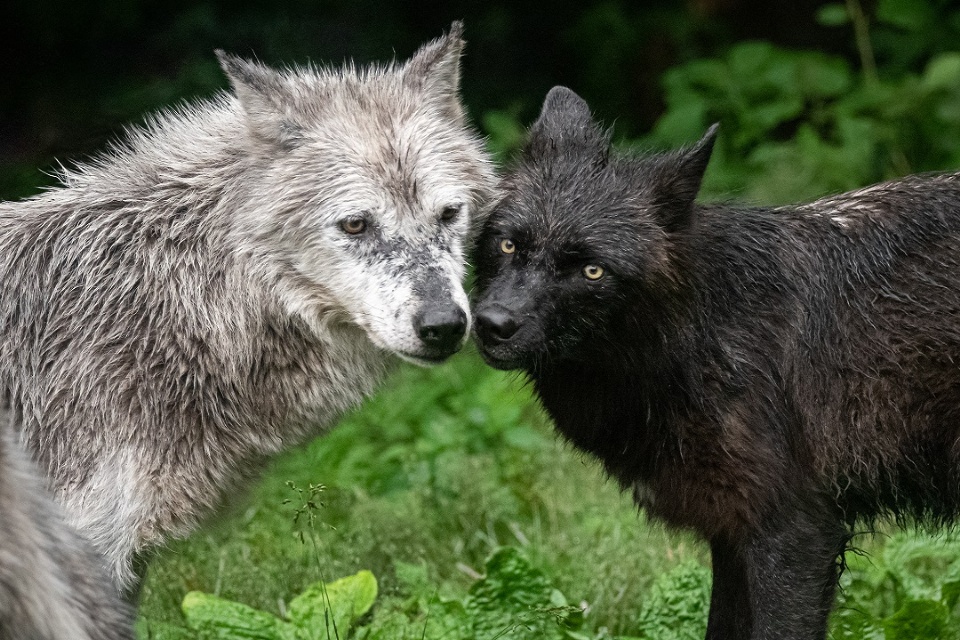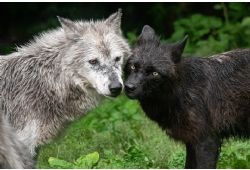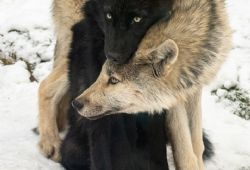Haliburton Forest & Wild Life Reserve Ltd. is a privately owned forest comprised of 100,000 acres located in Haliburton, Ontario, close to Algonquin Provincial Park.
It includes the popular, well-renowned Haliburton Forest Wolf Centre and canopy walk. Haliburton Forest was deemed as the first sustainable forest in Canada certified by the International Forest Stewardship Council in Canada.The centre operates year-round for recreation, tourism and educational programs. Attractions include eco-log homes, snowmobiling, fishing, sawmill tours, astronomy and more. The main attraction, however, is the Wolf Centre. The 5000 square foot interior centre includes an indoor museum, a theatre featuring documentaries on wolves and a gift shop. People can also watch the wolves via “live cam” on the Haliburton Forest website. The wolves occupy a space of seven acres of wild, forested land.Marena Wigmore is the Wolf Centre Coordinator and is absolutely passionate about wolves. She talks about them with pride and affection and refers to them as ‘her kids’. Wigmore frequented the centre since she was a little girl and says fell into her current job. Wigmore started working summers at the Wolf Centre part-time in 2014 when she was a student. Family friend Paul Brown ran the Wolf Center for years and hoped that one day Wigmore would replace him. Well, it happened on May 20th, 2020 (despite the fact that she studied law).Wigmore’s responsibilities include interacting with visitors, working behind the scenes, feeding the wolves, merchandising promotional items, creating new programs and displays and most importantly, ensuring the wolves are healthy and happy.Wigmore says the best time to visit the wolves is during the winter, as they have a thick, full coat, the ‘classic’ wolf image. They are also more active and playful during winter. The Wolf Centre differs from other centres as the wolves are kept as wild as possible in their natural environment. Wigmore educates the public all about wolves. There is a large observation window where visitors can view the six wolves. Wigmore says her favorite part is listening to first-time visitors exclaim, “Wow, this is awesome!” when they first glimpse the wolves. “It is always an extremely special moment,” she says.Meet the Six StarsLuna is 11 years old and the alpha female. She is large in stature and has given birth to eight litters of puppies with three to five pups per litter. She is a black wolf, although now mostly gray. She is dominant and it will be difficult for another beta female to replace her. Although Luna can still bear pups, she was unable to feed her last set of pups.Piper, Wigmore’s favourite, is seven years old and the alpha male. He is silver-gray and has a very docile personality. He has a dark head and is the only mature male wolf in the pack. Piper is not fond of being the center of attention.Quest is six years old, a beta female. She is very patient and is biding her time until she can take the reins from Luna. Currently, Quest is the lowest ranked wolf in the pack.There are also three younger wolves, two brothers and a sister from the same litter. Uriel is a very large high-ranking beta male who is bold in nature and will probably replace Piper as the alpha male. Union, another beta male, thinks he is a ‘cool cat’, but no one else agrees. He is light brown and turning whitish in some places. Wigmore thinks he just may get into trouble one day with his arrogant character. Ula is a petite, adorable, dark black wolf with fox-like features. Both she and Uriel look alike, but Uriel is much larger.The goal of the center is for visitors to be educated and learn as much as possible about wolves. Through observation, one can study their inter-relationships, eating habits, battles, unique personalities and literally watch them grow up.Interesting facts:
- Wolves mature at 2 ½ to 3 years old
- Males are 15% to 20% larger than females.
- A typical female weighs 55-80 lbs, males weigh 65-120 lbs.
- These six wolves form a pack and live as a family unit.
- They don’t fight about sharing food, but they certainly do grumble!
- Wolves do not drink much water; they get their water through food or by eating snow.
- Wolves eat only once every 5 to 10 days. Their diet consists of dead deer, moose or beaver. They can gorge on 15-20 lbs of meat at a time. When finished eating, they have a visibly distended belly.
- Yes, wolves really do have eyelashes—a little girl asked Wigmore this question!
- Their teeth are beautiful and white because they chew on raw bones.
- The force of their bite is 1500 lbs per square inch (German Shepherds have 700-750 lbs per square inch)
- Although thought to mate for life, wolves will choose another partner if their mate dies.
- It was thought that wolves howl at the moon. They actually howl most when weather conditions are clear which is when we see the moon. Their soulful howl carries when the air is crisp and the night is clear.
- They are very clean animals who like to groom each other. If they have leftover food on their muzzle, they will clean it off on the snow or grass.
1305 Redkenn Road, Haliburton, Ontario K0M 1S0
1 800 631-2198
Facebook: HF Wolf Centre
www.Haliburtonforest.com

 In The Latest Issue:
In The Latest Issue:



 BY:
BY: 

Tweet
Share